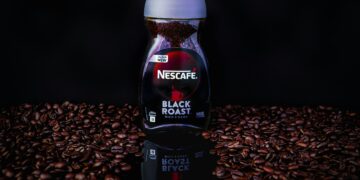Table of Contents
Introduction: My Summer of Discontent
It was one of those sweltering July afternoons where the air itself feels heavy.
The promise of a quick, cheap, and refreshing iced coffee, made from the jar of instant granules in my pantry, seemed like a stroke of genius.
I pictured the perfect glass: tall, frosty, and smooth.
The reality, as it always was, was a crushing disappointment.
I’d spoon the dark, crystalline dust into a glass, add cold milk, and begin the ritual of futility: stirring.
And stirring.
And stirring.
What I was left with was a beverage that defied logic.
It was a watery, insipid liquid, yet it carried a harsh, acrid bitterness.
Stubborn, undissolved clumps of coffee floated on the surface like tiny, bitter rafts, while a gritty, muddy sludge inevitably settled at the bottom of the glass.1
Each sip was a reminder of my failure.
This wasn’t just a bad drink; it was a betrayal of the very word “instant.”
As a food writer, I spend my days wrestling with complex recipes, from multi-day sourdoughs to delicate sauces.
Yet, I was consistently defeated by this, the simplest of kitchen tasks.
My frustration wasn’t just about a bad cup of coffee; it was about a promise of convenience that turned into a gritty, unsatisfying lie.
That summer, I decided to solve this problem once and for all.
Chapter 1: The Anatomy of a Failed Iced Coffee
Before finding a solution, I needed to understand the failure.
My sad, clumpy iced coffee wasn’t a personal failing; it was a predictable outcome of a flawed process, a frustration shared by countless others online who lamented the same undrinkable results.3
The problem was threefold: texture, flavor, and a fundamental misunderstanding of the material itself.
Deconstructing the Failure
The most immediate offense was the texture.
The granules simply refused to dissolve in cold liquid, creating a gritty mouthfeel from the first sip to the last sludgy dregs.4
The flavor was a paradox.
The drink tasted weak because not enough of the desirable coffee compounds were rehydrating, yet it was simultaneously harsh and bitter, a flavor profile often described as “stale” or “burnt”.6
This highlights the worst characteristics of mass-market instant coffee, which often uses lower-quality beans and harsher processing methods.
But the deepest issue was psychological.
Instant coffee is sold on the promise of speed and ease.
When the result is an undrinkable mess that requires more effort than it’s worth, it feels like a scam.
It’s a deeply unsatisfying experience that leaves you with a dirty glass and a caffeine headache.
The Misunderstanding of the Material
The breakthrough came when I realized I was thinking about instant coffee all wrong.
I was treating the granules like tiny, ground coffee beans, assuming the cold water was supposed to “brew” or “extract” flavor from them.
This is the central fallacy.
Instant coffee isn’t raw material; it’s a finished product that has been dehydrated.
The process involves brewing massive batches of coffee from real beans and then removing all the water, either through spray-drying or freeze-drying, to leave behind soluble coffee crystals.3
The brewing has already happened in a factory.
The flavor, the acidity, the bitterness—it’s all been decided and locked into those granules.
My job in my kitchen was not extraction, but rehydration.
I wasn’t a brewer; I was a chemist trying to return a dehydrated solid to its original liquid state.
This shift in perspective was everything.
The “cold brewing” model was doomed to fail because it misinterprets the scientific task at hand.
To succeed, I needed a new model, one based on the principles of dissolving a solid in a liquid.
Chapter 2: The Epiphany in a Teaspoon: A Lesson from High School Chemistry
After yet another gritty failure, I remembered a tip I’d seen buried in an online forum: “dissolve it in a little hot water first”.11
Skeptical but desperate, I tried it.
I spooned my usual amount of instant coffee into a glass, but this time, I added just a couple of tablespoons of hot water from the kettle.
I stirred.
In seconds, the granules vanished, melting into a dark, glossy, syrupy liquid.
There were no clumps, no grit.
I then added my cold milk and a handful of i.e. I took a sip.
It was perfect—impossibly smooth, perfectly blended, and richly flavorful.
It was the iced coffee I had been chasing all summer.
The hack worked, but I needed to know why.
The answer took me back to high school chemistry class.
The Scientific “Why”: Introducing the Supersaturated Solution Framework
The failure of the cold-water method and the success of the hot-water trick boil down to one thing: the science of solubility.
For most solids, solubility increases with temperature.13
The molecules in hot water possess more kinetic energy; they move faster and collide with the coffee granules more frequently and with greater force, effectively breaking the solute apart and dissolving it.15
Cold water molecules are sluggish by comparison, lacking the energy to efficiently break down the granules, which leads to the dreaded clumps.4
The “hot slurry” method I had stumbled upon was, in scientific terms, a clever way of creating a supersaturated solution.17
Here’s how it works:
- Increase Solubility: By adding a small amount of hot water (the solvent), you dramatically increase its capacity to dissolve the instant coffee (the solute).
- Create Concentration: You can dissolve a large amount of coffee into that tiny volume of hot water—far more than would be possible if the water were cold. This creates a stable, highly concentrated liquid known as a supersaturated solution.19
- Effortless Dilution: When you then pour in your cold milk or water, you are no longer trying to dissolve a stubborn solid. You are simply diluting one liquid with another, a process that is nearly effortless.
This “supersaturated solution” framework was the key.
It replaced the flawed “cold brewing” model with a correct scientific principle.
It explained why the simple hack was so effective and, more importantly, it gave me the knowledge to control the process.
I was no longer just following a tip; I was manipulating chemistry.
This understanding transformed me from a frustrated coffee drinker into an empowered creator.
Chapter 3: The “Hot Slurry” Method: Your Foolproof Blueprint for Perfect Instant Iced Coffee
Armed with this new understanding, I perfected a simple, replicable method.
This is the blueprint that will save you from gritty, bitter iced coffee forever.
- Create the Concentrate: In your serving glass, combine 1 to 2 tablespoons of your chosen instant coffee with 2 tablespoons of hot water. The ideal water temperature is between 195°F and 205°F (90°C to 96°C)—just off the boil. This is hot enough to dissolve the coffee efficiently but not so hot that it scalds it, which can create a “burnt” taste.11 Stir until a smooth, thick, syrupy liquid forms. Ensure every single granule is dissolved.
- Sweeten the Deal (Optional): If you use granulated sugar, honey, or a thick syrup, add it now. The residual heat of the coffee concentrate will dissolve sweeteners instantly and completely, eliminating any risk of graininess in the final drink.11
- The Cold Plunge: Add 6 to 8 ounces of cold water or your milk of choice (whole milk, oat milk, almond milk, etc.). Stir gently. You will notice the dark concentrate swirls and blends into the cold liquid with almost no effort.
- The Final Chill: Add a full cup of ice. Because you started with a mostly cold beverage, the ice serves to chill the drink to its final temperature without melting excessively and watering it down.
Chapter 4: A Connoisseur’s Guide to the Instant Coffee Aisle
Now that you’ve mastered the method, it’s time to consider the materials.
The quality of your instant coffee has a huge impact on the final taste.
The instant coffee aisle can be a confusing place, but understanding a few key distinctions will make you an expert shopper.
The Manufacturing Divide: Why Jars and Packets Differ
The texture and flavor of instant coffee are largely determined by how it was dried.
- Spray-Dried: In this process, brewed coffee is misted into a chamber of very hot air (around 475°F or 245°C). The water evaporates almost instantly, leaving behind a fine powder. This method is fast and inexpensive, but the intense heat can destroy many of the coffee’s delicate aromatic compounds, often resulting in a flatter, more bitter, or “burnt” flavor. This is common in many budget-friendly, mass-market brands.10
- Freeze-Dried: This is a gentler, more complex process. Brewed coffee is frozen into a slab, broken into granules, and placed in a strong vacuum. The vacuum causes the frozen water to turn directly into vapor (a process called sublimation), leaving the coffee solids behind. Because it avoids high heat, freeze-drying preserves significantly more of the coffee’s original aroma and nuanced flavor. It is a more expensive process and is typically used for higher-quality instant coffees.10
- Micro-Ground Hybrid: Some premium brands, most notably Starbucks VIA, use a hybrid approach. They blend freeze-dried instant coffee with a small amount of coffee beans that have been ground into an ultrafine powder. This is done to add back some of the body, aroma, and complexity of a freshly brewed cup.24
The Bean Divide: Arabica vs. Robusta
Just like with whole-bean coffee, the type of bean matters.
- Arabica: Generally considered the higher-quality bean, Arabica is prized for its complex, aromatic, and often slightly sweet and acidic flavor profiles. Most specialty instant coffees are made from 100% Arabica beans.23
- Robusta: As the name suggests, this is a hardier plant. Robusta beans have a stronger, bolder, more “classic” coffee flavor. They are also typically more bitter and contain significantly more caffeine than Arabica beans. Many budget instant coffees use Robusta or a blend heavy on Robusta to keep costs down and deliver a strong caffeine kick.23
The Instant Coffee Hierarchy
To simplify your shopping, think of the market in three tiers.
This framework will help you find the right product for your taste and budget.
| Tier | Representative Brands | Key Characteristics | Flavor Profile | Best For… |
| Specialty & Boutique | Blue Bottle, Intelligentsia, Verve, Waka, Swift Coffee, Tandem 28 | Almost always freeze-dried, 100% single-origin Arabica beans. | Nuanced, bright, complex, with distinct flavor notes. Closely mimics a specialty pour-over or drip coffee. | Coffee connoisseurs, drinking it black, and accurately replicating a third-wave café experience at home. |
| Elevated Grocery | Starbucks VIA, Nescafé Gold, Café Bustelo, Juan Valdez 6 | Typically freeze-dried or a micro-ground hybrid. Often uses 100% Arabica or an Arabica-dominant blend. | Balanced, robust, and aromatic with a clear coffee flavor. Less bitter than budget options. | A reliable and delicious daily driver that holds up well to milk, cream, and sugar. The sweet spot for quality and value. |
| Budget & Basic | Folgers, Maxwell House, Nescafé Clásico, store brands 6 | Usually spray-dried and often uses Robusta beans or a significant portion in the blend. | A strong, classic “instant” taste that can be one-dimensional, flat, or overtly bitter. | Budget-conscious shoppers, use in baking recipes, or for those who prefer their coffee heavily modified with cream and sugar. |
Chapter 5: The Alchemist’s Handbook: Advanced Flavor Balancing & Customization
With a perfect method and high-quality materials, you can now move into the realm of true mastery.
This is where you learn to fine-tune your cup to your exact preferences, addressing the common complaints of bitterness and acidity, and even incorporating modern coffee trends.
Taming Bitterness: The Salt Trick
Even with the best technique, some coffees are just inherently bitter, especially those made with Robusta beans.7
The fix is surprisingly simple: a tiny pinch of salt.
This isn’t an old wives’ tale; it’s science.
Our tongues have receptors for different tastes, and sodium ions physically block our bitterness receptors, preventing them from sending a “bitter” signal to the brain.33
The salt doesn’t remove the bitter compounds, but it effectively masks your perception of them.
Be warned: a delicate hand is required.
Start with just a few grains of salt.
For ultimate control, you can create a simple saline solution (1 part salt to 4 parts water) and add it to your coffee drop by drop until the harsh edge softens.
Neutralizing Acidity: The Baking Soda Trick
If your coffee tastes unpleasantly sour or upsets your stomach, the issue is likely high acidity.35
The solution here is a tiny pinch of baking soda (sodium bicarbonate).
This is a straightforward acid-base neutralization reaction.
The alkaline baking soda chemically raises the pH of the acidic coffee, making it smoother and gentler.37
Like with salt, less is more.
Too much will leave your coffee tasting flat or soapy.
For historical context, this is a modern version of the “cowboy coffee” trick, where pioneers would add crushed eggshells (which contain alkaline calcium carbonate) to the pot to settle the grounds and smooth out the brew.38
Advanced Customization for the Modern Drinker
The modern coffee landscape is filled with new trends and dietary preferences.
With a bit of food science, your instant iced coffee can be adapted to fit them perfectly.
- For Creamy, Keto-Friendly Coffee: A popular trend is adding healthy fats like MCT oil, coconut oil, or butter to coffee. The problem is that oil and water don’t mix. Simply stirring them in results in a greasy, separated mess. The solution is an emulsifier, a molecule with a water-loving (hydrophilic) end and an oil-loving (hydrophobic) end that allows the two to combine into a stable suspension.40 For beverages, powdered sunflower lecithin is an excellent choice. It’s highly effective in water-based systems, has a neutral flavor, and is widely available.42
- Method: After creating your “hot slurry” concentrate, add your oil or butter and a small pinch (about 1/4 teaspoon for a 12-ounce drink) of powdered sunflower lecithin. Use a handheld milk frother or a blender to blitz for 10-15 seconds. This will create a perfectly stable, creamy emulsion. Then, add your cold liquid and ice as usual.
- For Naturally Infused Flavors: To move beyond artificial syrups, you can infuse your coffee with natural flavors using a classic mixology technique called cold maceration. This gentle process is perfect for extracting the delicate aromatic compounds from ingredients without “cooking” them and introducing bitter notes.44
- Method: Prepare your instant iced coffee as usual. Then, add your flavoring agent—a few sprigs of fresh mint, a wide peel of orange or lemon (pith removed), a cinnamon stick, or a few cracked cardamom pods. Let the mixture sit, covered, in the refrigerator for anywhere from a few hours to a full day. The longer it sits, the stronger the flavor will be. Taste it periodically. When it reaches your desired intensity, simply strain out the solids and enjoy.
Conclusion: From Frustration to Ritual
That jar of instant coffee in my pantry is no longer a monument to my kitchen failures.
It’s a tool.
The daily act of making my afternoon iced coffee has transformed from a disappointing chore into a small, satisfying ritual rooted in a little bit of science.
The gritty sludge and bitter taste have been replaced by a smooth, perfectly customized drink that I can create in minutes.
This journey taught me that mastery in the kitchen—and perhaps elsewhere—comes not just from following a recipe, but from understanding the “why” behind the technique.
By learning a little about solubility, chemical reactions, and emulsification, I didn’t just solve a coffee problem.
I transformed a daily moment of frustration into a moment of quiet, delicious triumph.
And that is a powerful alchemy indeed.
Works cited
- Can you make instant coffee with cold water? – Reddit, accessed August 6, 2025, https://www.reddit.com/r/Coffee/comments/czhiip/can_you_make_instant_coffee_with_cold_water/
- Can you make instant coffee with cold water? : r/LivingEssentials – Reddit, accessed August 6, 2025, https://www.reddit.com/r/LivingEssentials/comments/1ls4rvj/can_you_make_instant_coffee_with_cold_water/
- How does instant coffee dissolve? – Reddit, accessed August 6, 2025, https://www.reddit.com/r/Coffee/comments/xnux84/how_does_instant_coffee_dissolve/
- Does Instant Coffee Dissolve In Cold Water? Powder Vs. Crystals Plus A Tasty Recipe, accessed August 6, 2025, https://coffeegeargurus.com/does-instant-coffee-dissolve-in-cold-water/
- Coffee not dissolving why and how to? : r/NoStupidQuestions – Reddit, accessed August 6, 2025, https://www.reddit.com/r/NoStupidQuestions/comments/zs6gto/coffee_not_dissolving_why_and_how_to/
- 9 Instant Coffee Brands, Ranked Worst To Best – Tasting Table, accessed August 6, 2025, https://www.tastingtable.com/1755382/instant-coffee-brands-ranked-worst-best/
- Why is instant coffee bad? : r/IndiaCoffee – Reddit, accessed August 6, 2025, https://www.reddit.com/r/IndiaCoffee/comments/16iegef/why_is_instant_coffee_bad/
- Why does instant coffee taste so bad now? : r/IndiaCoffee – Reddit, accessed August 6, 2025, https://www.reddit.com/r/IndiaCoffee/comments/1h0dfsv/why_does_instant_coffee_taste_so_bad_now/
- www.chowhound.com, accessed August 6, 2025, https://www.chowhound.com/1812986/best-instant-coffee-for-iced-coffee/#:~:text=It’s%20brewed%20the%20usual%20way,also%20bake%20with%20instant%20coffee.
- Coffee 101: Everything You Need to Know About Instant Coffee, accessed August 6, 2025, https://www.wakacoffee.com/blogs/coffeelifeblog/everything-to-know-about-instant-coffee
- Easy 1 Minute Instant Iced Coffee – Frosting and Fettuccine, accessed August 6, 2025, https://frostingandfettuccine.com/instant-iced-coffee/
- can you make cold brew coffee with instant coffee : r/coldbrew – Reddit, accessed August 6, 2025, https://www.reddit.com/r/coldbrew/comments/11mumhu/can_you_make_cold_brew_coffee_with_instant_coffee/
- 13.4: Effects of Temperature and Pressure on Solubility, accessed August 6, 2025, https://chem.libretexts.org/Bookshelves/General_Chemistry/Book%3A_General_Chemistry%3A_Principles_Patterns_and_Applications_(Averill)/13%3A_Solutions/13.04%3A_Effects_of_Temperature_and_Pressure_on_Solubility
- What is the effect of temperature on solubility? – Examples | CK-12 Foundation, accessed August 6, 2025, https://www.ck12.org/flexi/chemistry/LeChateliers-Principle/what-is-the-effect-of-temperature-on-solubility/
- What factors affect solubility? – AAT Bioquest, accessed August 6, 2025, https://www.aatbio.com/resources/faq-frequently-asked-questions/what-factors-affect-solubility
- Lesson 5.6: Does Temperature Affect Dissolving? – American Chemical Society, accessed August 6, 2025, https://www.acs.org/middleschoolchemistry/lessonplans/chapter5/lesson6.html
- byjus.com, accessed August 6, 2025, https://byjus.com/chemistry/supersaturated-solution/#:~:text=A%20supersaturated%20solution%20is%20a%20solution%20that%20contains%20more%20than,crystal%2C%20called%20a%20seed%20crystal.
- Supersaturated Solution – BYJU’S, accessed August 6, 2025, https://byjus.com/chemistry/supersaturated-solution/
- Supersaturation – Wikipedia, accessed August 6, 2025, https://en.wikipedia.org/wiki/Supersaturation
- Supersaturated – (Intro to Chemistry) – Vocab, Definition, Explanations | Fiveable, accessed August 6, 2025, https://library.fiveable.me/key-terms/intro-chem/supersaturated
- Bitter Coffee 101: Why It Happens (+3 Ways To Fix It) – ESPRO, accessed August 6, 2025, https://espro.com/blogs/coffee-talk/bitter-coffee-101-why-it-happens-3-ways-to-fix-it
- Make Instant Iced Coffee in ONE MINUTE – YouTube, accessed August 6, 2025, https://www.youtube.com/watch?v=wr1hU6jZaG8
- Best Instant Coffee for Coffee Snobs in 2025—According to One, accessed August 6, 2025, https://www.lowkeycoffeesnobs.com/best-instant-coffee-for-coffee-snobs/
- Unpacking the many varieties of instant coffee, accessed August 6, 2025, https://prestocoffee.com/blogs/coffee/unpacking-the-many-varieties-of-instant-coffee
- What are the different types of instant coffee? – Seasoned Advice, accessed August 6, 2025, https://cooking.stackexchange.com/questions/128812/what-are-the-different-types-of-instant-coffee
- Instant coffee recommendations?? : r/camping – Reddit, accessed August 6, 2025, https://www.reddit.com/r/camping/comments/1c7fs7e/instant_coffee_recommendations/
- Confession: I love instant coffee – Reddit, accessed August 6, 2025, https://www.reddit.com/r/Coffee/comments/i3ewkc/confession_i_love_instant_coffee/
- I Tasted 17 Instant Coffees and Found Many That Were Genuinely Great – Serious Eats, accessed August 6, 2025, https://www.seriouseats.com/best-instant-coffee-7506045
- I Asked 2 Baristas To Name the Best Instant Coffee—They Both Said the Same Brand, accessed August 6, 2025, https://www.simplyrecipes.com/best-instant-coffee-baristas-11776978
- We Tested Instant Coffees—These Are the Ones That Deliver on Flavor – Allrecipes, accessed August 6, 2025, https://www.allrecipes.com/longform/best-instant-coffee/
- The Best Instant Coffees For A Smooth And Refreshing Iced Coffee – Chowhound, accessed August 6, 2025, https://www.chowhound.com/1812986/best-instant-coffee-for-iced-coffee/
- Why is instant coffee hated so much even though it’s not terrible? – Reddit, accessed August 6, 2025, https://www.reddit.com/r/Coffee/comments/1i9n3ma/why_is_instant_coffee_hated_so_much_even_though/
- Make Bitter Coffee Taste Better with This Secret Ingredient – Food Hacks – WonderHowTo, accessed August 6, 2025, https://food-hacks.wonderhowto.com/how-to/make-bitter-coffee-taste-better-with-secret-ingredient-0150711/
- Exploring Salt in Coffee: Reducing Bitterness Explained | TikTok, accessed August 6, 2025, https://www.tiktok.com/@jameshoffmanncoffee/video/7278997940167855392
- Why does all my instant coffee taste sour : r/InstantCoffee – Reddit, accessed August 6, 2025, https://www.reddit.com/r/InstantCoffee/comments/lchdtk/why_does_all_my_instant_coffee_taste_sour/
- Instant iced coffee stomach pains ? : r/traderjoes – Reddit, accessed August 6, 2025, https://www.reddit.com/r/traderjoes/comments/1do6o3i/instant_iced_coffee_stomach_pains/
- www.kimbocoffee.com, accessed August 6, 2025, https://www.kimbocoffee.com/blogs/kimbo-blog/how-to-reduce-coffee-acidity#:~:text=Just%20a%20pinch%20of%20baking,without%20changing%20the%20taste%20much.&text=Adding%20milk%20to%20your%20coffee%20also%20helps%20reduce%20acidity.
- How to Decrease the Acidity of Coffee – 3 Strategies, accessed August 6, 2025, https://zavida.com/blogs/coffee-methods/how-to-decrease-the-acidity-of-coffee-3-strategies
- Ways to Make Your Coffee Less Acidic, accessed August 6, 2025, https://www.gridlockcoffee.com.au/blog/ways-to-make-your-coffee-less-acidic/
- www.eufic.org, accessed August 6, 2025, https://www.eufic.org/en/whats-in-food/article/what-are-emulsifiers-and-what-are-common-examples-used-in-food#:~:text=Here%2C%20the%20emulsifier%20is%20positioned,%2C%20homogenous%2C%20and%20smooth%20emulsion.
- Fats and oils: emulsification | Institute of Food Science and Technology – IFST, accessed August 6, 2025, https://www.ifst.org/lovefoodlovescience/resources/fats-and-oils-emulsification
- Gum Arabic vs. Plant-Based Lecithin: Choosing the Right Beverage Emulsifier – Lecitein, accessed August 6, 2025, https://www.lecitein.com/blog/gum-arabic-vs-plant-based-lecithin-choosing-the-right-beverage-emulsifier
- A Lesson in Lecithin – Kitchen Alchemy, accessed August 6, 2025, https://blog.modernistpantry.com/advice/a-lesson-in-lecithin/
- Getting flavour into drinks – Infusions, Hot vs Cold vs Flash – DeconDrinks, accessed August 6, 2025, https://decondrinks.wordpress.com/2017/09/23/infusion/
- Techniques: The Basics of Flavor Extraction – Campari Academy, accessed August 6, 2025, https://www.campariacademy.com/en-us/inspiration/flavor-extraction-basics/






